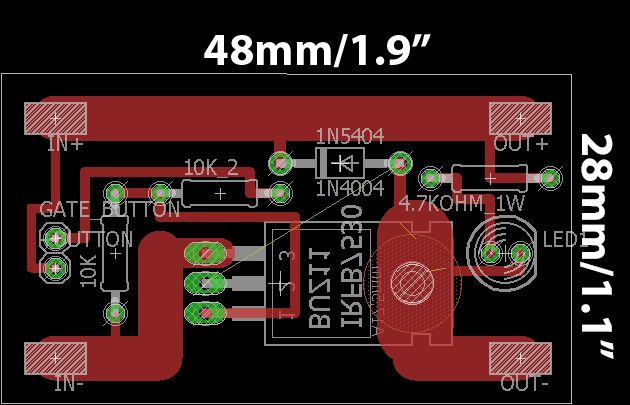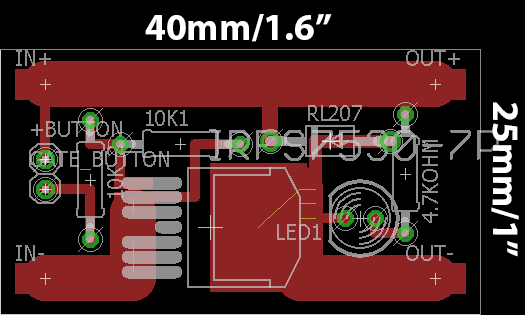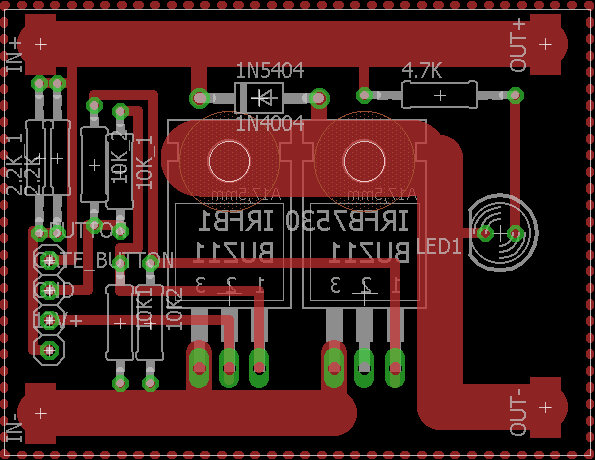Managed to make the original switch WAY smaller, now it comes in at only 48mm x 28mm!

Managed to make the original switch WAY smaller, now it comes in at only 48mm x 28mm!

And obviously re-did the IRFB7530-7P board as well. And its even smaller than the previous one!

Why does it only handle about 30-60A ? The FET is rated to 295A. What do i am overlooking?
Lol, so the max rating on a MOSFET is usually COMPLETE AND UDDER BULLSHIT. By that i mean like the TO-220 package leads will melt at around 75A so that’s out the window right there. And doing the math at 30A your going to see around a 94C degree temp rise on the 7530 which is fine but much higher and its gonna start to get sketchy. I heard that they literally COOL the IC’s in non conductive boiling liquid to test the max amperage, so yeah unless your planning on doing that, then don’t even worry about the supposed “max amperage” for the MOSFET, do the heat calc your self and figure out a safe operating amperage, or Google it and you’ll figure out the true max safe amperage.
I am just curious because the “Vedder Anti Spark Switch” is kinda standard but no one said that it is maxed to 60A… So the Vedder Switch cannot handle more than 60A? Somehow i doubt it but i am glad if somebody can enlighten me 
Well this Vedder Switch which is another great one and I highly recommend you take a look at, uses a 40A fuse on the positive rail which pretty much means, a 40A limit for the switch. I think it could possibly handle ~45A without a heat sink but I wouldn’t risk. And like I said just do the heat calculations because that is your main problem, heat generation and dissipation.
295A rating?? LOL did they get hobbyking to do their data sheets?
50A MAX
Mhm… how much does a heatsink help? What else can i do to increase the amperage rate of the switch?
EDIT: i am a fool… yeah it can handle 50A max at 12S (or whatever voltage) so the rate is more than enough. Correct?
im fairly sure vedders switch uses 2 FETS so that makes a theoretical 100A max
Well yeah 50A would be definitely near its limit and it would be getting damn hot though I think it would work (haven’t done the equation, I’m tired.) anyways most EBoards don’t draw 50A continous so its not a big deal and if you did need to draw 50A cont, you’d be better off using 2 fet’s in parallel like my dual fet schematics. Also heatsinking does help a lot though its still not fixing your under lying problem of drawing to much current from your fet.
I just had a wrong calculation… The motor can pull up to 80A so i thought this switch wont work but i forget that the battery does not provide 12S @ 80A!
Thank you very much 
Yeah no problem. The motor can draw upwards of 100A+ on its first start up though that is for an extremely small amount of time and the switch could handle that perfectly.
I am still confused somehow…
The battery provides 44,4V (12S) with a rather low amperage. Thus it will not melt the 40A fuse. Now i remembered that @hummie and @devin have measured some data:
This is the part where i get confused. The wattmeter is between the battery and the ESC so the amps peak should have blown a AntiSparkSwitch!?
It would be alright to setup the VESC battery max = <40A and the motor to 80A? It would be the same acceleration/torque if battery max is at 40A instead of 80A?
Thanks in advance for enlighten me!
I got parts for 3 of these and am having issues with all of em. I’ll keep diagnosing.
Parts for 3 Vedder Switches? If you figure out what’s wrong make sure to drop that in the Vedder thread to benefit others. Also a good place to deal help would be that thread as well.
Personally I don’t have a VESC, wish I did though, so I can’t tell you exactly how the VESC would behave but, escalating the max amperage can give you more torque because like I said when the motors first start up they draw a lot of current and the VESC may limit that because you set it to 40A max so it would be better to set it higher in that case. Though like I said I don’t know to much about the VESC so I’m not the right person to ask sorry. And the reason the fuse doesn’t blow is because its drawing that current for a very short amount of time so the fuse doesn’t have enough time to heat up and break.
I was reading more about paralleling MOSFETS and you can’t use one resistor for the same gates of the MOSFET’s because they will “fight” over the voltage for the gate capacitance so I have to go and change that on the dual fet circuit’s.
EDIT: Updated images, schm and brd files to accommodate this change.
Yep! Will do.
Dual IRFB7530 version with 12V LED push button integration.

The gate resistors for the MOSFET('s) can not always be just 10K resistors! I was originally doing this and its wrong! The 2 resistors act as a voltage divider for the gate but you have to make sure the voltage is not over the Vgs max of the MOSFET. For a 12S build you will need a 24-32K Ohm resistor on the positive side and a 10K on the negative side of the voltage divider. For a 10S build 18-25K Ohm on positive side and 10K on negative. For an 8S build 2x 10K’s would be fine but a 12K on the positive side would be better. 6S Build two 10K’s are fine as well. You can also use a mismatch of different resistor values using a Voltage Divider Calculator to calculate the required values, just don’t use any resistors under ~1K Ohms. I put an example below so you can get a better understanding.
USING A 12V ZENER DIODE TO DRIVE THE GATE WOULD BE BEST! Using a 12V Zener would mean the gate always gets 12V no matter what the voltage is, as long as it’s above 12V obviously.